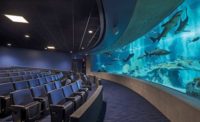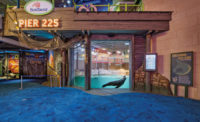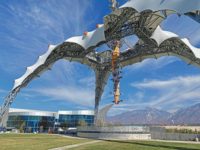OdySea Aquarium
Scottsdale, Ariz.
Region ENR Southwest
Sports/Entertainment
Project Team
Owner/Developer Odysea Aquarium LLC
Design Firm Deutsch Architecture Group
General Contractor McCarthy Building Cos.
Civil Engineer Hunting Engineering
Structural Engineer Caruso Turley Scott
MEP Engineer Piping Systems Engineering
Subcontractors Schuff Steel; K&F Electric; Pete King; Suntec; Blount; Gothic Landscaping; Roofing Southwest; Stone Cold Masonry; Schindler Group
OdySea, the Southwest’s largest aquarium at 200,000 sq ft, not only features more than 50 exhibits and 500 different species of marine life but also envelops its attractions within a unique circular structure featuring specially designed steel and concrete support elements.
Built at a cost of $52.5 million, the aquarium features elevated cast-in-place concrete aquariums with 5,500 sq ft of acrylic viewing windows. Life-support systems include more than 300 pumps and 42,000 linear ft of piping. The exteriors are cast-in-place concrete and tilt-up panels. To execute the design and construction of the circular structure, the project team used Revit and BIM 360 Glue.
“Following detailed virtual coordination, construction was then executed by our skilled workforce of carpenters, acrylic installation teams and ironworkers,” says Mike Gonzalez, vice president, McCarthy Building Cos.
Due to the structure’s concentric shape, a traditional grid system or otherwise standard construction dimensional relationships were not calculable. Consequently, the construction team used GPS coordinates to determine position. Structural elements within the three-dimensional model were assigned real world latitude, longitude and elevation coordinates, and then all structural components were sized, shaped and located using a total station that conveyed points in the field to the thousandth of a foot.
A structural steel theater turntable manufactured in China called for tight concentricity tolerances. The horizontal and vertical concentricity tolerances at the carousel were plus or minus a quarter inch at both the inner and outer radius, with the outer radius spanning 40 ft 5 in.
“The concentricity tolerances were only used at the carousel because this was the only rotating structure within the building,” says Gonzalez.
Karen Ohmann, architect with Deutsch Architecture Group, says the complicated project’s preconstruction phase was especially critical due to specialty items requiring extended lead times. The 14-ft by 40-ft radial acrylic windows, for example, were designed in the U.S., manufactured in Thailand and delivered to the site 14 weeks later.
Concrete work was self-performed by McCarthy, most of it curved to a tolerance of less than one degree. Length and height were kept at less than a quarter of an inch to design specifications. More than 5,455 sq ft of cast-in-place concrete acrylic windows, 1,100 structural beams and 72 concrete tilt panels fit the first time with no rework.
Daniel Van Cuyk, lead engineer for Caruso Turley Scott, says cooperation and communication among McCarthy, Deutsch Architecture Group and Schuff Steel, among others, were the key to limiting rework.
“OdySea is an architectural and structural marvel that came together more seamlessly than projects one-tenth its size. The lack of field issues was a testament to a fantastic team working in unison,” Van Cuyk says.
By McCarthy’s estimates, the firm self-performed about 30% of the project including concrete, plumbing, piping and ductwork, inclusive of the tank structures and 16 cast-in-place tanks. McCarthy crews also installed the life support systems that sustain the fish and other animals.
Since OdySea is located in the Salt River Pima-Maricopa Indian Community, the owners and design-construction team integrated several themes including exterior concrete patterns that depict a raindrop falling into a river. Walkways into OdySea represent the five major Arizona rivers: Colorado, Gila, Salt, Santa Cruz and Verde. Construction began in March 2015 and was completed on schedule in September 2016.









